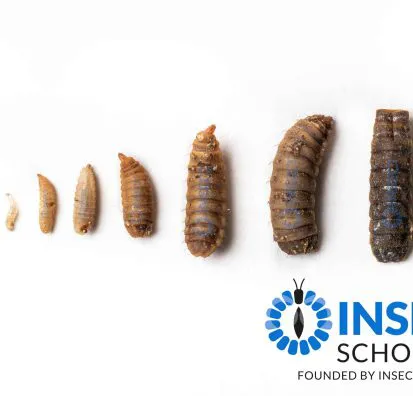Optimizing Black Soldier Fly Larvae Growth: The Role of Protein and Energy Ratios

The Black Soldier Fly (BSF) larvae have garnered significant interest for their role in sustainable waste management and as a protein-rich feed source. To optimize BSF larvae growth, it is crucial to focus on the nutritional composition of their rearing substrates, particularly the protein and carbohydrate contents, and their ratios. Understanding the protein-energy ratio is also essential to ensure that dietary protein is utilized effectively for growth rather than being wasted as an energy source.
The Importance of Protein and Carbohydrates
Protein and carbohydrates are vital nutrients for the growth and development of insects, especially for species like BSF that have a non-feeding adult stage. Here’s why these nutrients are critical:
- Proteins: They are essential for insect growth and metabolism, serving as building blocks for enzymes, hormones, and structural components. Proteins are involved in virtually all biological processes, making them indispensable for larval development.
- Carbohydrates: They provide the primary dietary energy source for larvae. Carbohydrates are also used as backbones for certain amino acids and as building blocks for chitin, a structural polysaccharide in the exoskeleton. This dual role highlights the importance of carbohydrates in both energy provision and structural integrity.
The Protein-Carbohydrate Ratio
Formulating an ideal substrate for BSF larvae requires not only optimal levels of protein and carbohydrates but also an optimal ratio between these two nutrients. The balance between protein and carbohydrates influences larval growth, development, and overall health. An imbalanced ratio can lead to inefficient nutrient utilization, impacting the larvae’s growth performance.
The Protein-Energy Ratio
Beyond the protein-carbohydrate ratio, the protein-energy ratio is another crucial factor in designing effective rearing substrates. This ratio ensures that dietary protein is primarily used for growth and tissue synthesis rather than being diverted for energy production. When protein is used as an energy source, it results in the production of waste products like urea or uric acid, which can further convert to ammonia emissions, posing environmental and health risks.
To optimize the protein-energy ratio, it’s important to:
- Know the Total Energy Content: Calculate the gross energy content of the larval substrate. This is the total amount of energy available from the diet, usually measured in megajoules (MJ).
- Determine the Energy-Feeding Rate: Calculate the energy-feeding rate (e.g., MJ per larva) by considering the total energy content and the number of larvae in the substrate. This metric helps quantify the quality of the substrate in terms of its ability to meet the energy requirements of the larvae.
- Balance the Diet: Ensure that the diet provides sufficient energy from carbohydrates and fats so that proteins are spared for growth functions. This balance helps in achieving optimal growth rates and efficient nutrient utilization.
Practical Implications and Future Research
Optimizing the protein-energy ratio in BSF rearing substrates can significantly enhance production efficiency and yield. Here are some practical implications and areas for future research:
- Substrate Formulation: Develop substrates with balanced protein and carbohydrate contents, tailored to the specific growth stages of BSF larvae. This can involve experimenting with different raw materials to achieve the desired nutrient ratios.
- Nutrient Monitoring: Regularly monitor the nutrient composition of the substrates to ensure they meet the optimal ratios. Adjustments may be necessary based on larval growth performance and environmental conditions.
- Environmental Impact: Study the environmental impact of different protein-energy ratios, particularly in terms of ammonia emissions. Aim to develop substrates that minimize waste production and environmental footprint.
- Longitudinal Studies: Conduct long-term studies to understand the effects of varying protein and energy ratios on larval development, adult emergence, and reproductive success. This can provide deeper insights into the nutritional needs of BSF throughout their lifecycle.
Optimizing the protein and energy ratios in the diet of Black Soldier Fly larvae is essential for maximizing growth and production efficiency. By understanding and balancing these nutritional parameters, producers can enhance the sustainability and effectiveness of BSF rearing operations. Future research should continue to refine these ratios and explore innovative substrate formulations to support the growing BSF industry.
For more information about:
- Insect Bioconversion of Waste, please contact us at the Insect school. https://www.insectschool.com/
- Turnkey Insect Farms – https://www.insectengineers.com/bsfturnkey/production
- If you would like to book BSF industry keynote speaker Bob Holtermans for your event – https://www.insectengineers.com/about-us/speaker-bobholtermans














